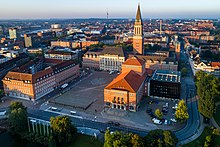Kiel Town Hall
The Kiel City Hall is the city hall of the Schleswig-Holstein state capital, Kiel . The 106 m high town hall tower is one of its landmarks .
Town halls of the city of Kiel
The previous town hall on the Alter Markt became too small around 1900 for the then rapidly growing naval and shipyard town. Therefore, from 1907 to 1911 the current town hall with tower was built in the suburb on today's town hall square west of the old town. It has long been referred to as the “New Town Hall”.
The Old Town Hall was built in World War II, except for a few cellars completely destroyed. In 2000 the house on Rathausplatz no longer offered enough space for the municipal offices. That is why, especially since 2008, parts of the city administration have been relocated to the building of the former Oberpostdirektion in Andreas-Gayk- Strasse. Since then, this building has been called the “New Town Hall”.
architecture
The city had the town hall, which is now a listed building, built from 1907 to 1911 according to the designs of the Karlsruhe architect Hermann Billing . Following the tradition of the representative town hall building, the building has its own tower. It rises from a connecting structure between two inner courtyards and is designed in the style of a campanile like the Markus Tower of the lagoon city of Venice . This collapsed in 1902 and was rebuilt from 1903, which was also reported by German construction magazines. The 106 m high Kiel Tower, however, towers over the Markus Tower by 7.4 m. There is a viewing platform at a height of 67 m.
Carillon
A carillon sounds from the tower every quarter of an hour , which lets you hear another quarter of the melody up to the hour. The Kiel vernacular underlined the carillon with the mocking verse from the beginning because the costs had already risen far above plan during the construction of the town hall:
- "Kiel hett keen money / dat weet de world / if there's something creeping / dat weet you nich."
The composer of the glockenspiel is the royal music director Heinrich Johannsen (born July 30, 1864 in Lauenburg; † February 8, 1947 in Eutin), who wrote a letter in 1946 about the origin of the chimes : "I chose ... the 4th Tones of the so-called Westminster strike (consisting of fifth, root, second and third), to which I added the lower octave of the root as the 5th tone. "
The key is E major. The fact that the Westminster chime used is a musical motif or a traditional melody is an explanation for the catchiness of the carillon of the Kiel City Hall, which is very similar to the bell ringing of the Big Ben clock tower in London or the bell ringing of the Copenhagen City Hall .
tourism
The tower of the town hall can be visited as part of guided tours. An elevator goes up to the viewing level at a height of 67 m, which goes around the tower and provides wide views over the city center and the harbor in the northeast, the eastern bank of the Kiel Fjord , the main station and the Hörn in the south and the western settlements as far as Mettenhof .
literature
- Eva-Maria Karpf: 100 years of Kiel Town Hall 1911–2011. Kiel 2011, ISBN 978-3-00-034867-9 ( PDF file; 2 MB ).
- Jörg Talanow: Kiel - the way it was. Vol. 2, Droste, Düsseldorf 1978, ISBN 3-7700-0509-0
- Jörg Talanow: Kiel - Modern seen historically. Schmidt and Klaunig, Kiel 1972
- Original letter from Kgl. Music director Heinrich Johannsen from 1946
See also
Remarks
- ^ Deert Lafrenz: The Kiel town hall - a monument of early modernism. In: Uwe Albrecht, Regina Becker (Hg): Kiel: Urban space under the sign of the sea. Regensburg 2015, pp. 35–66.
- ^ Eva-Maria Karpf: 100 Years of Kiel Town Hall 1911–2011. Kiel 2011, ISBN 978-3-00-034867-9 , p. 20.
- ↑ "Kiel has no money / the world knows / whether it will get (receive) something / you don't know." - There is also a (lesser-known) original rhyme, the carillon - which, by the way, has been since May 28, 1911 can be heard - was awarded. This has the following wording: "De Klock, se sleit, de Tied, de geiht, ni to veel Quark, fix Hand an't Wark!" [The clock / bell that strikes, the time that passes, never (not) too much quark (nonsense, doing nonsense or talking), quickly getting to work (put or put)]. Jörg Talanow reports this in his 1972 work "Kiel - Modernes Historically".
- ↑ The letter of the King. Music director Heinrich Johannsen, from which this excerpt comes, is in the Kiel city archive in the original and was also quoted in extracts on the same topic in the Kieler Nachrichten of August 4, 1964.
- ↑ s. Also description on Kiel.de , accessed on February 20, 2020
Web links
- City Hall: Politics & Administration for Kiel (State Capital Kiel)
- City hall history (s) (state capital Kiel)
- Kiel Town Hall - Drawings and photos from the Hermann Billing estate in the Architecture Museum of the Technical University of Munich
Coordinates: 54 ° 19 ′ 21 ″ N , 10 ° 7 ′ 57 ″ E



